Chuckanut 50 km
14/09/16 16:23
It was a very rainy winter, the rainiest since 1999, so having Chuckanut on the horizon was probably a good thing because it kept me motivated. But there were some pretty damp slogs out there 😃
Which begs the question: why run such an early season race? Well after the Squamish 50K last August (https://www.evernote.com/l/AYSfrYO2qWJLD4zrVDVjeG17jrH_FBcWQBg), I told Gary (one of my two awesome coaches) that I wanted to do a 50 miler in 2016. He responded that I needed to have at least two more 50Ks under my belt before I bit off a 50 miler (80 km !) so I sussed out two that I could do this spring before the build up for the 50 mile.
Chuckanut was perfect timing. When I first got into trail running, I heard about it and - at the time - thought “I am never doing that race; could be a mud fest in March.” Since then I have done so much more running in the rain and wet that I am somewhat inoculated. Like I said, it was a rainy winter.
Race week, I started to feel the edges of fear. At first, I thought I was just having weird symptoms but Lynne asked me if I was afraid. That made me think about it and I realized that she was right. I was afraid of the whole body pain that was the Squamish 50k over the last 15 km. Plus when I talked to Gary on the phone the Tuesday before the race, he told me:
NO MATTER HOW FIT, HOW PREPARED YOU ARE, IT WILL BE REALLY HARD.
The pain will be similar to Squamish 50k but experience helps you get through it.
Other than that, I felt great. I was less tired during my taper than last time and actually felt too energetic in the last couple of days, like I wanted to run the firewood into the house type of thing.
Eric didn’t start my taper until 2.5 weeks out and I still ran just about every day in the final week. Which is better for me than grinding to a stop. Plus it helped to run tempo a few days out - as leg speed is not my forte.
Lynne and I drove down on Friday afternoon, checked into the lux race hotel and picked up the package. We had a fantastic dinner and I went to bed at 8:44 with ear plugs in. Good thing as Lynne was up for half the night; the hotel is right on the water, just like the freight train. In fact, the train tracks were about 10 feet from our window. Silicon ear plugs, baby.
Up by 5:30ish on race morning with 8.5 hours sleep. How great is that. I attribute some of my sleeping prowess to the vitamin and magnesium IV that I had Friday morning (thanks Natasha) as the magnesium makes me sleepy.
My roadie not so happy at first😔
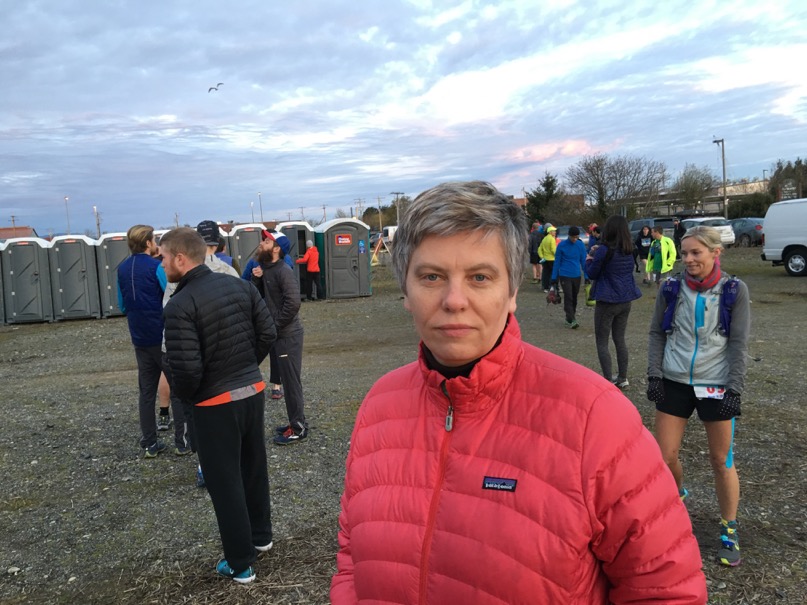
But I found her coffee and that eventually kicked in.
Me, I felt great. Just wanted it to start.
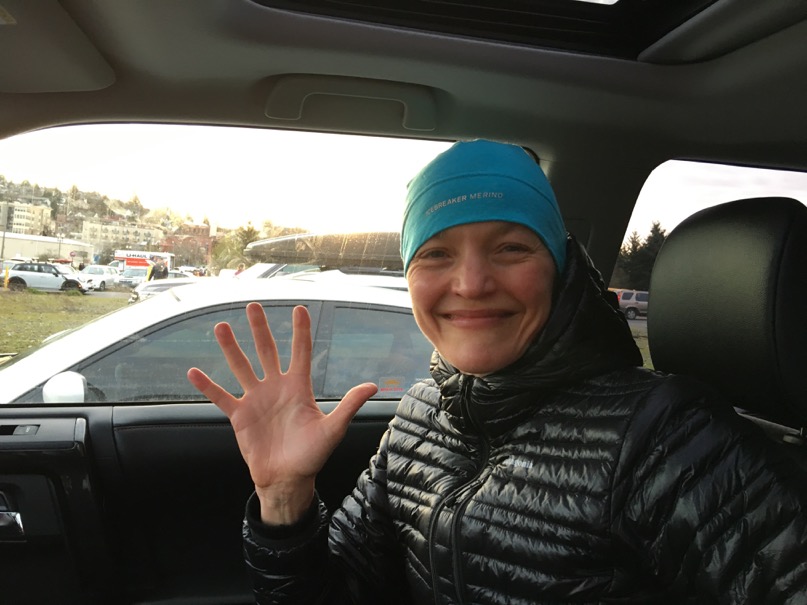
Normal standing around in the cold. Lynne and I both noticed how fit this particular race crowd was.
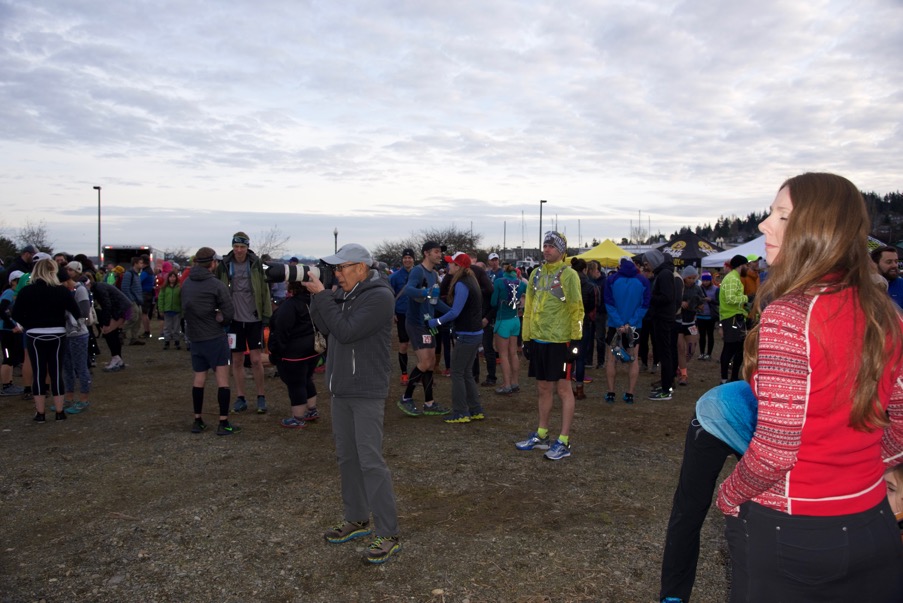
With last minute adjustments to increase the tension.
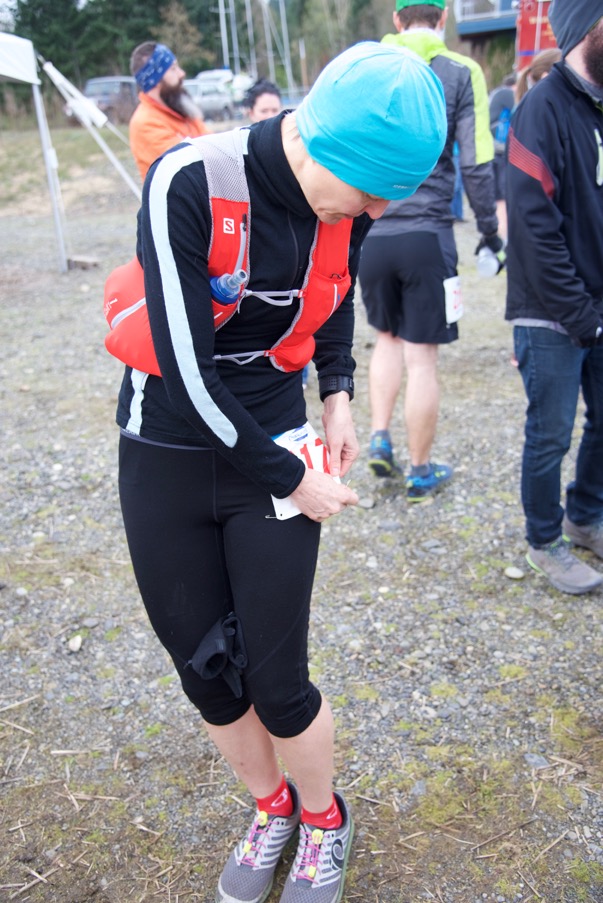
Finally started.
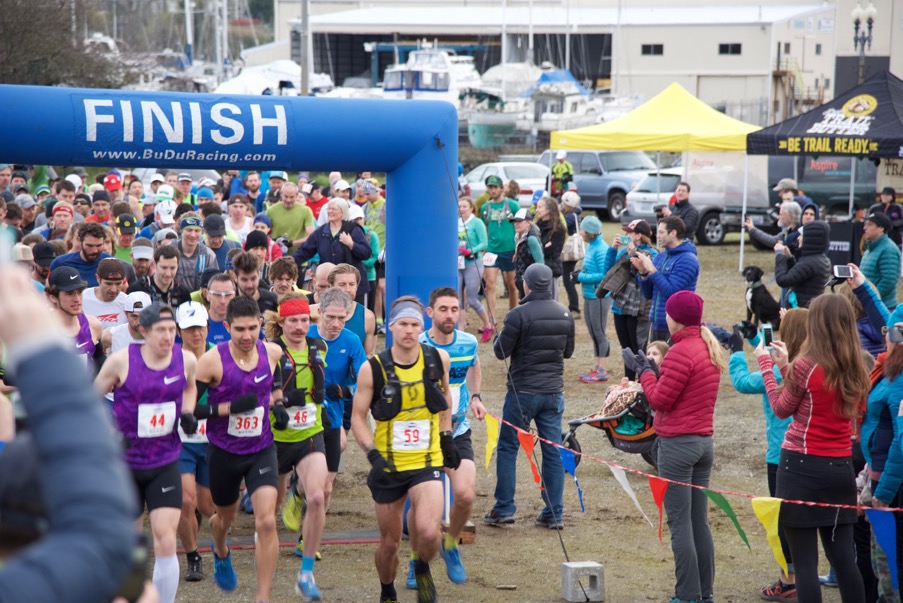
First the super fast guys.
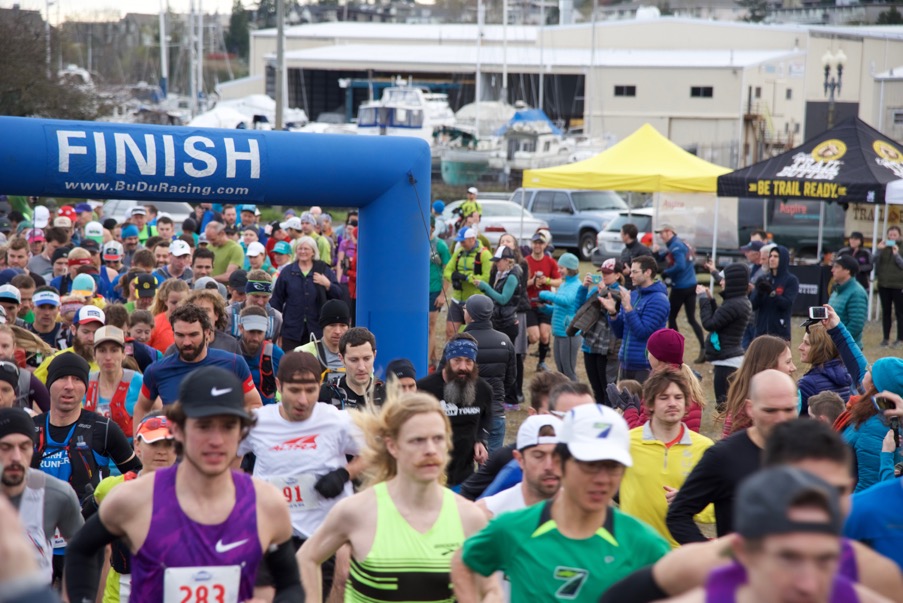
Then us.
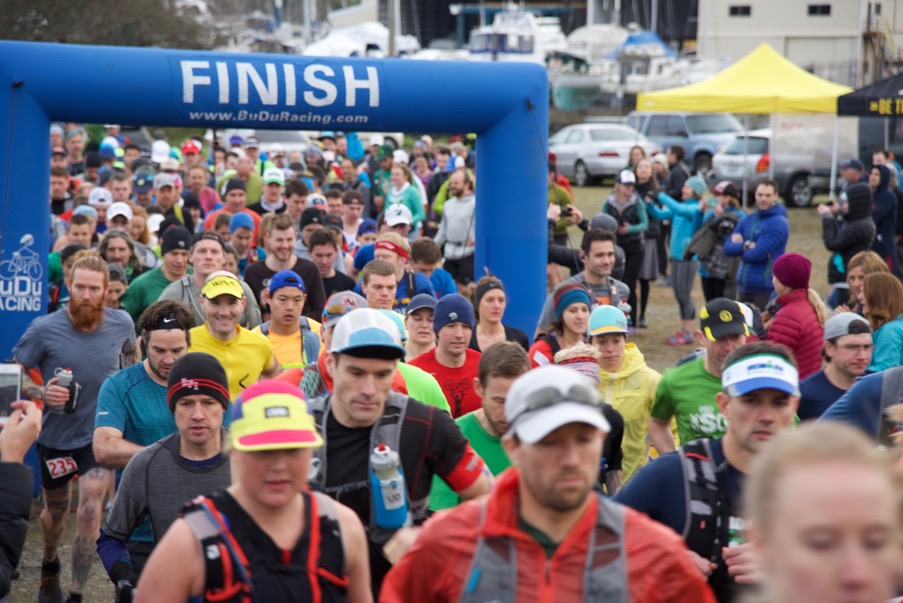
The Chuckanut course is a lollipop with 11.2 km flat (6.7 miles), then a mix of steep trail, FSR, an 8 mile loop around a lake, then a one mile climb with 1000 feet of climbing, following by a long forest descent, and back to the original 11.2 km flat. Basically, it is like an 11 km warmup followed by the equivalent of Run Ridge Run (a 25 km climb fest which I did 3 weeks earlier: https://www.evernote.com/l/AYT-zWLiKIZNP6xY70Fy_NYylr0LPaz4UQs ) followed by a heavy legged flatish 11 k.
When you start, you feel good so the inclination is to cover early miles fast. BUT Gary was crystal clear with me: the key to this race is to control the pace.
Keep it under control for the first 10 km
Want the SAME pace in the last 10 km (will just be a lot harder).
So I kept a beady eye on Tomtom and decided that I would not go a beat over my upper zone 2 until the first aid station. In fact, my plan was to ride that sweet spot between zone 2 and tempo for the whole race. Which is pretty much what happened.
It took me 1:11 to get to the first aid station. Quite a few people passed me on that first flatish section (NOTE: there were a couple of climbs on the so-called flat; the descents would haunt me on the return) At the first AS, I whipped out my pocket cup from Salomon (the race is cup free and zero waste), had a couple of swigs and chased after the folks who had passed me. I like racing from behind (mostly because I am always behind) probably because I may not have speed but I am getting better at pace control. On that first long climb, I started to pass people.
Then you come out onto a dirt road. Very steep with an array of racers hiking the steeps above me. I counted 10 and my goal was to pass them all. Which I did by the 2nd AS. Makes me sound fast but actually not the case. Lynne has urged me to race more and suggested this tactic - which really works (thanks baby). At the 2nd AS, made my biggest mistake. I just sailed through grabbing some water in my portably cup. But did not re-fill my only water bottle.
Started the 8 mile (12 km) forest loop. This loop is somewhat technical and definitely hilly but, for North Shore and Squamish runners, just not that big a deal. About 3 miles in, I jumped off a rock on a descent and turned my left ankle. The pain was searing but I remembered what my high school cross country coach said about turned ankles. Always run on them right away. In this case, he was right (he was probably wrong about those 50 mile weeks !), I started running and the pain went away.
About 5 miles in, I started to be really really really thirsty. I kept looking at hikers and wondering if I could ask them for water (too shy) and glanced longingly at streams. But, in the end, just sucked it up. The AS was farther away than usual as there had been a big storm and downed trees prevented them stocking the normal AS3 but eventually made it to water and stocked up.
By this time, I was not only dehydrated but way, way too hot. At the race start, it was 7˚. Now it was 15˚. I wanted to take off my clothes and leave them on the forest floor but, hey that icebreaker was expensive and, more than anything, I kept remembering that it is a zero waste race.
AS 3 is at the base of Chinscrapper, the famed and legendary climb that takes 30 miles approx to cover a mile. STEEP.
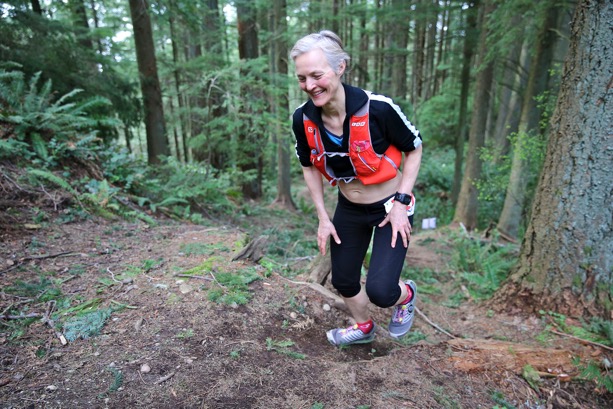
Finally started down the last descent. Fast at first but then started to feel the twinges of a very very tight TFL on my right hip. More and more sore. Hey, that sucks, I thought. So slowed my descent down a little in the hopes that the final 11 km would be runnable. On the way out, I had heard a woman tell another runner in hushed tones: last time I ran this, I stiffened into cement on the last 10 km and had to walk almost all the way. I really wanted to be able to follow Gary’s instructions and run the last 10 km as fast as the first 10 km.
Everyone has a secret goal time. Mine was 6:59. I knew that that would stretch me but was doable. As Lance Armstrong’s DS said when he started his comeback there are no miracles in racing. That time was just barely attainable pour moi. I had worked out that I needed to hit the last AS at 5:45 to hit my A+ goal time. And I did. So I ran right through the AS and started out on the long, long flatish back stretch.
And then the hip pain hit me. Like a red hot flame travelling down my hip from the TFL to mid-thigh. I didn’t stop but tried rubbing it, in the hope of releasing the fascia. Not working. Then, I just tried letting the flame roll down my hip. That worked. Eventually my nervous system, getting no response, gave up. Perfect, just had to deal with the cement legs. Which was doable.
When we lived in Norway when i was a teenager, my Dad used to make up stories about the Swedish Road Stretcher who stretched the road for miles on long car trips. Eventually, the Canadian Road Shrinker would step in and save the day by shrinking the road back. Well, it seemed like the Swedish Road Stretcher won the day during the last leg.
At one point early on, a guy in a green shirt and long, loose lycra pants rolled up beside me and started telling me how he has suffered on the 8 mile loop but had taken 2 swigs of whiskey and now he was fine. I kind of liked his story but was glad when he pulled ahead to chat with white shirt in the distance. For a while, green shirt and white shirt ran together and I focused on keeping them in sight.
A thought kept popping into my head: how will I ever run 50 miles if I am so stiff after 30 miles? Finally, I decided that my Mom’s old advice sufficient unto the day are the evils thereof applied and I shut that thought out. But it is my next question for Gary...
I guess the whiskey didn’t work out well in the end because a couple of miles in, green shirt fell off pace and I passed him. But white shirt pulled me along in the distance despite the fact that my TFL was forcing me to trudge down the hills (downhill is really really hard on IT bands and everything that they touch). I kept running however and by the last mile or so, I reached white shirt. He stopped to walk and I clapped him on the shoulder and told him that he had kept me going and now he had to run with me. He looked a bit stunned but then introduced himself and told me that he had run the course a couple of times before when he was fitter.
We stiff legged it to the finish together.
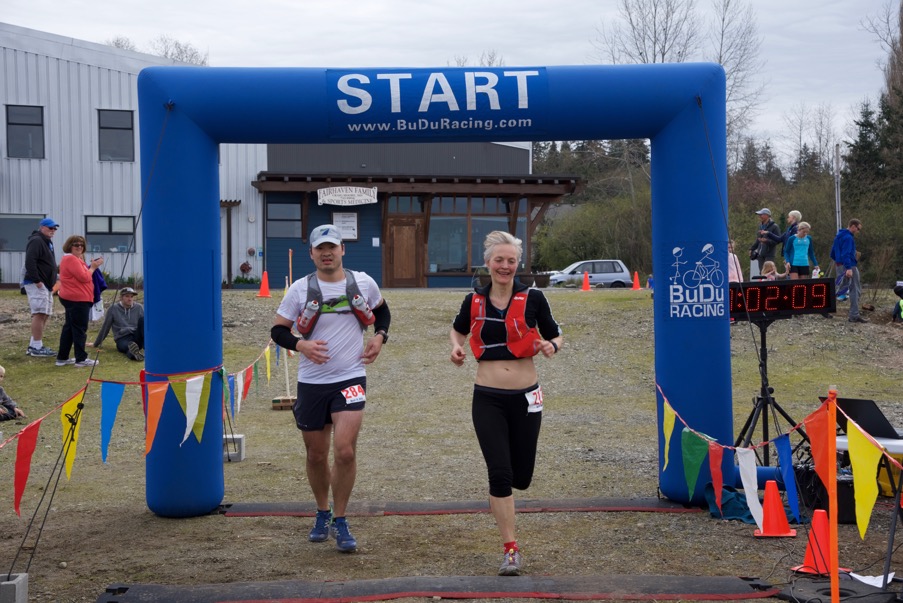
Final time: 7:02. Only 3 minutes off my A+ goal. I’ll take it 😃
(Just for perspective, Ellie Greenwood, the women’s winner brought it home in 4:11. )
Super thirsty but still had a smile for that volunteer.
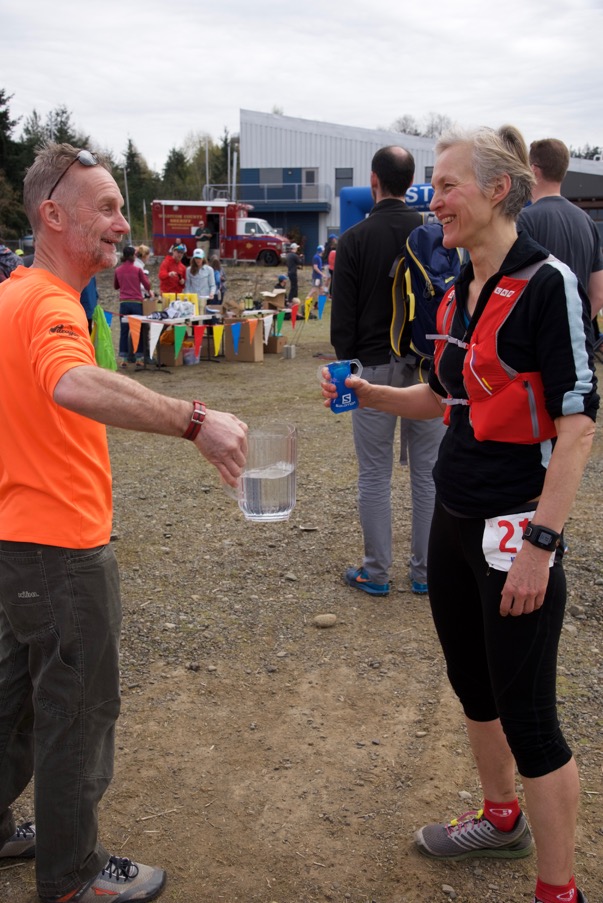
Lynne made me put my hands in the air. I am grateful cause I kind of like this shot.

Then I walked around and quizzed the Suunto guy about optical HRM (there is one in the works !) and Lynne pointed out that I was so much less of a basket case than after the last 50 km.
Maybe 50K is the new 25K 😃
And I ran the first 11.2 km at a 6:51 per km pace and the last 11.2 at a 6:57 pace. Race of patience.
For the techies below (just shut this down if you are not interested in tiny, little technical minutiae :))
The race at a glance:
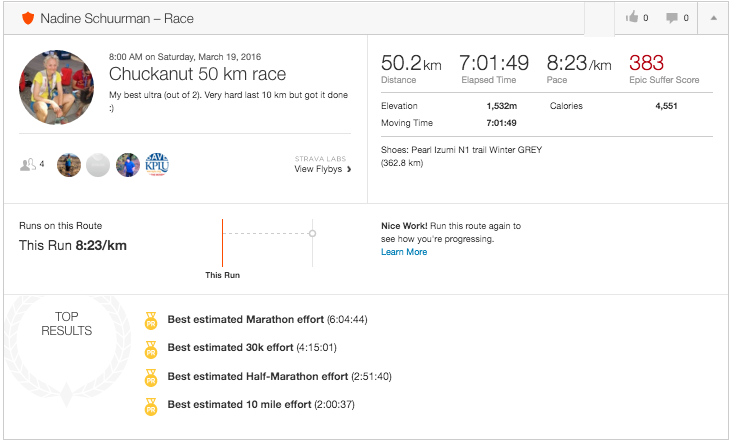
Splits below:
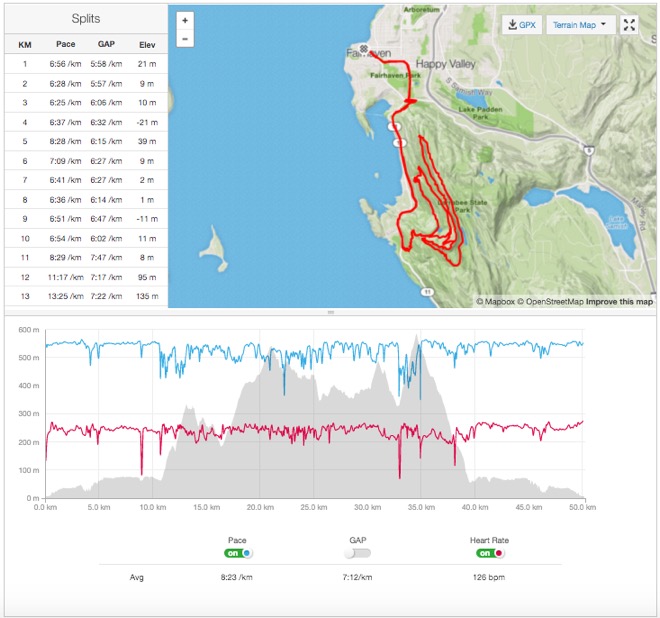
Okay, still have a long way to go: 238/312 starters (301 finishers). And only 4/6 female in my age group (as my sister said on the phone yesterday those fast chicks again).
Which begs the question: why run such an early season race? Well after the Squamish 50K last August (https://www.evernote.com/l/AYSfrYO2qWJLD4zrVDVjeG17jrH_FBcWQBg), I told Gary (one of my two awesome coaches) that I wanted to do a 50 miler in 2016. He responded that I needed to have at least two more 50Ks under my belt before I bit off a 50 miler (80 km !) so I sussed out two that I could do this spring before the build up for the 50 mile.
Chuckanut was perfect timing. When I first got into trail running, I heard about it and - at the time - thought “I am never doing that race; could be a mud fest in March.” Since then I have done so much more running in the rain and wet that I am somewhat inoculated. Like I said, it was a rainy winter.
Race week, I started to feel the edges of fear. At first, I thought I was just having weird symptoms but Lynne asked me if I was afraid. That made me think about it and I realized that she was right. I was afraid of the whole body pain that was the Squamish 50k over the last 15 km. Plus when I talked to Gary on the phone the Tuesday before the race, he told me:
NO MATTER HOW FIT, HOW PREPARED YOU ARE, IT WILL BE REALLY HARD.
The pain will be similar to Squamish 50k but experience helps you get through it.
Other than that, I felt great. I was less tired during my taper than last time and actually felt too energetic in the last couple of days, like I wanted to run the firewood into the house type of thing.
Eric didn’t start my taper until 2.5 weeks out and I still ran just about every day in the final week. Which is better for me than grinding to a stop. Plus it helped to run tempo a few days out - as leg speed is not my forte.
Lynne and I drove down on Friday afternoon, checked into the lux race hotel and picked up the package. We had a fantastic dinner and I went to bed at 8:44 with ear plugs in. Good thing as Lynne was up for half the night; the hotel is right on the water, just like the freight train. In fact, the train tracks were about 10 feet from our window. Silicon ear plugs, baby.
Up by 5:30ish on race morning with 8.5 hours sleep. How great is that. I attribute some of my sleeping prowess to the vitamin and magnesium IV that I had Friday morning (thanks Natasha) as the magnesium makes me sleepy.
My roadie not so happy at first😔

But I found her coffee and that eventually kicked in.
Me, I felt great. Just wanted it to start.

Normal standing around in the cold. Lynne and I both noticed how fit this particular race crowd was.

With last minute adjustments to increase the tension.

Finally started.

First the super fast guys.

Then us.

The Chuckanut course is a lollipop with 11.2 km flat (6.7 miles), then a mix of steep trail, FSR, an 8 mile loop around a lake, then a one mile climb with 1000 feet of climbing, following by a long forest descent, and back to the original 11.2 km flat. Basically, it is like an 11 km warmup followed by the equivalent of Run Ridge Run (a 25 km climb fest which I did 3 weeks earlier: https://www.evernote.com/l/AYT-zWLiKIZNP6xY70Fy_NYylr0LPaz4UQs ) followed by a heavy legged flatish 11 k.
When you start, you feel good so the inclination is to cover early miles fast. BUT Gary was crystal clear with me: the key to this race is to control the pace.
Keep it under control for the first 10 km
Want the SAME pace in the last 10 km (will just be a lot harder).
So I kept a beady eye on Tomtom and decided that I would not go a beat over my upper zone 2 until the first aid station. In fact, my plan was to ride that sweet spot between zone 2 and tempo for the whole race. Which is pretty much what happened.
It took me 1:11 to get to the first aid station. Quite a few people passed me on that first flatish section (NOTE: there were a couple of climbs on the so-called flat; the descents would haunt me on the return) At the first AS, I whipped out my pocket cup from Salomon (the race is cup free and zero waste), had a couple of swigs and chased after the folks who had passed me. I like racing from behind (mostly because I am always behind) probably because I may not have speed but I am getting better at pace control. On that first long climb, I started to pass people.
Then you come out onto a dirt road. Very steep with an array of racers hiking the steeps above me. I counted 10 and my goal was to pass them all. Which I did by the 2nd AS. Makes me sound fast but actually not the case. Lynne has urged me to race more and suggested this tactic - which really works (thanks baby). At the 2nd AS, made my biggest mistake. I just sailed through grabbing some water in my portably cup. But did not re-fill my only water bottle.
Started the 8 mile (12 km) forest loop. This loop is somewhat technical and definitely hilly but, for North Shore and Squamish runners, just not that big a deal. About 3 miles in, I jumped off a rock on a descent and turned my left ankle. The pain was searing but I remembered what my high school cross country coach said about turned ankles. Always run on them right away. In this case, he was right (he was probably wrong about those 50 mile weeks !), I started running and the pain went away.
About 5 miles in, I started to be really really really thirsty. I kept looking at hikers and wondering if I could ask them for water (too shy) and glanced longingly at streams. But, in the end, just sucked it up. The AS was farther away than usual as there had been a big storm and downed trees prevented them stocking the normal AS3 but eventually made it to water and stocked up.
By this time, I was not only dehydrated but way, way too hot. At the race start, it was 7˚. Now it was 15˚. I wanted to take off my clothes and leave them on the forest floor but, hey that icebreaker was expensive and, more than anything, I kept remembering that it is a zero waste race.
AS 3 is at the base of Chinscrapper, the famed and legendary climb that takes 30 miles approx to cover a mile. STEEP.

Finally started down the last descent. Fast at first but then started to feel the twinges of a very very tight TFL on my right hip. More and more sore. Hey, that sucks, I thought. So slowed my descent down a little in the hopes that the final 11 km would be runnable. On the way out, I had heard a woman tell another runner in hushed tones: last time I ran this, I stiffened into cement on the last 10 km and had to walk almost all the way. I really wanted to be able to follow Gary’s instructions and run the last 10 km as fast as the first 10 km.
Everyone has a secret goal time. Mine was 6:59. I knew that that would stretch me but was doable. As Lance Armstrong’s DS said when he started his comeback there are no miracles in racing. That time was just barely attainable pour moi. I had worked out that I needed to hit the last AS at 5:45 to hit my A+ goal time. And I did. So I ran right through the AS and started out on the long, long flatish back stretch.
And then the hip pain hit me. Like a red hot flame travelling down my hip from the TFL to mid-thigh. I didn’t stop but tried rubbing it, in the hope of releasing the fascia. Not working. Then, I just tried letting the flame roll down my hip. That worked. Eventually my nervous system, getting no response, gave up. Perfect, just had to deal with the cement legs. Which was doable.
When we lived in Norway when i was a teenager, my Dad used to make up stories about the Swedish Road Stretcher who stretched the road for miles on long car trips. Eventually, the Canadian Road Shrinker would step in and save the day by shrinking the road back. Well, it seemed like the Swedish Road Stretcher won the day during the last leg.
At one point early on, a guy in a green shirt and long, loose lycra pants rolled up beside me and started telling me how he has suffered on the 8 mile loop but had taken 2 swigs of whiskey and now he was fine. I kind of liked his story but was glad when he pulled ahead to chat with white shirt in the distance. For a while, green shirt and white shirt ran together and I focused on keeping them in sight.
A thought kept popping into my head: how will I ever run 50 miles if I am so stiff after 30 miles? Finally, I decided that my Mom’s old advice sufficient unto the day are the evils thereof applied and I shut that thought out. But it is my next question for Gary...
I guess the whiskey didn’t work out well in the end because a couple of miles in, green shirt fell off pace and I passed him. But white shirt pulled me along in the distance despite the fact that my TFL was forcing me to trudge down the hills (downhill is really really hard on IT bands and everything that they touch). I kept running however and by the last mile or so, I reached white shirt. He stopped to walk and I clapped him on the shoulder and told him that he had kept me going and now he had to run with me. He looked a bit stunned but then introduced himself and told me that he had run the course a couple of times before when he was fitter.
We stiff legged it to the finish together.

Final time: 7:02. Only 3 minutes off my A+ goal. I’ll take it 😃
(Just for perspective, Ellie Greenwood, the women’s winner brought it home in 4:11. )
Super thirsty but still had a smile for that volunteer.

Lynne made me put my hands in the air. I am grateful cause I kind of like this shot.

Then I walked around and quizzed the Suunto guy about optical HRM (there is one in the works !) and Lynne pointed out that I was so much less of a basket case than after the last 50 km.
Maybe 50K is the new 25K 😃
And I ran the first 11.2 km at a 6:51 per km pace and the last 11.2 at a 6:57 pace. Race of patience.
For the techies below (just shut this down if you are not interested in tiny, little technical minutiae :))
The race at a glance:

Splits below:

Okay, still have a long way to go: 238/312 starters (301 finishers). And only 4/6 female in my age group (as my sister said on the phone yesterday those fast chicks again).
